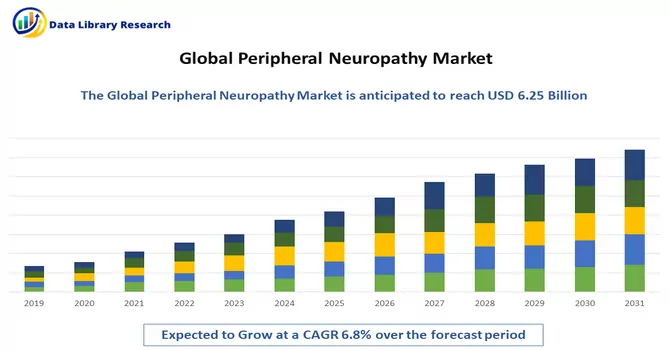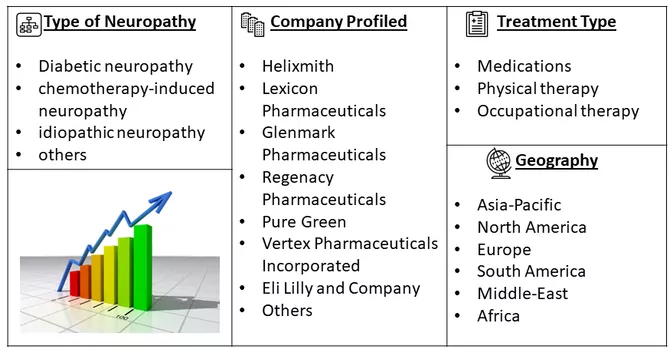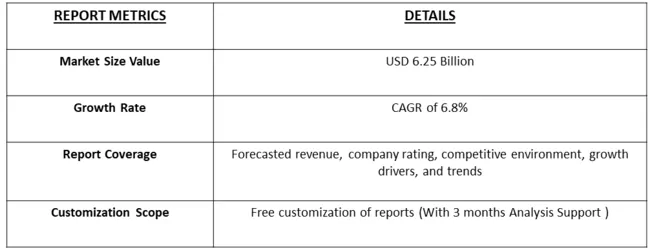The peripheral neuropathy market size was valued at USD 6.25 Billion in 2023 & is projected to register a CAGR of 6.8% in forecast period, 2024-2031.

Get Complete Analysis Of The Report - Download Free Sample PDF
The peripheral neuropathy market encompasses a range of pharmaceuticals, medical devices, and therapeutic interventions aimed at managing the symptoms and underlying causes of peripheral neuropathy, a condition characterized by damage to the peripheral nerves. With a growing prevalence attributed to factors such as diabetes, chemotherapy, and aging populations, the market has witnessed steady expansion. Key market players are continually innovating to develop novel treatments, including medications targeting neuropathic pain, nerve regeneration therapies, and advanced diagnostic technologies for early detection and monitoring.
Moreover, increasing awareness about the condition among healthcare professionals and patients, coupled with rising healthcare expenditure worldwide, is expected to drive further growth in the peripheral neuropathy market. However, challenges such as limited treatment options for certain neuropathies, regulatory hurdles, and reimbursement issues remain significant considerations for market stakeholders. Efforts to address these challenges and capitalize on emerging opportunities are essential for sustaining growth and improving outcomes in the peripheral neuropathy market. One of the primary growth driving factors for the peripheral neuropathy market is the increasing prevalence of conditions associated with nerve damage, such as diabetes, chemotherapy-induced neuropathy, and autoimmune diseases. As these conditions become more prevalent globally due to factors like aging populations and unhealthy lifestyle choices, the incidence of peripheral neuropathy is also expected to rise. This surge in patient population fuels the demand for effective treatment options, leading to the development of innovative pharmaceuticals, medical devices, and therapeutic interventions aimed at managing neuropathic pain, promoting nerve regeneration, and improving overall quality of life for patients. Additionally, advancements in diagnostic techniques and healthcare infrastructure contribute to early detection and intervention, further propelling market growth. Overall, the growing prevalence of conditions leading to peripheral neuropathy underscores the need for continuous innovation and investment in research and development to address this significant healthcare challenge.
Market Segmentation: The Peripheral Neuropathy Market is Segmented by Type of Neuropathy (diabetic neuropathy, chemotherapy-induced neuropathy, idiopathic neuropathy, and others), Treatment Type (medications (e.g., pain relievers, antidepressants, anticonvulsants), physical therapy, occupational therapy, and others), and Geography (North America, Europe, Asia-Pacific, Middle East and Africa, and South America). The report offers the value (in USD million) for the above segments.

For Detailed Market Segmentation - Download Free Sample PDF
In the peripheral neuropathy market, several notable trends are shaping the landscape. Firstly, there is a growing focus on personalized medicine, driven by advancements in genomic research and biomarker identification. This trend is leading to the development of targeted therapies tailored to specific neuropathic conditions and patient profiles, improving treatment efficacy and reducing adverse effects. Additionally, there is an increasing emphasis on non-pharmacological interventions and holistic approaches to managing neuropathic pain, including physical therapy, acupuncture, and lifestyle modifications. Moreover, the rise of digital health technologies such as wearable devices and mobile health applications is enabling remote monitoring of symptoms, medication adherence, and disease progression, empowering patients and healthcare providers with real-time data for more informed decision-making. Lastly, collaborations between pharmaceutical companies, academic institutions, and research organizations are fostering innovation and driving the discovery of novel therapeutic targets and treatment modalities, promising new avenues for addressing the complex challenges associated with peripheral neuropathy.
Market Drivers:
Increasing Prevalence of Chronic Diseases:
Chronic diseases such as diabetes, autoimmune disorders, and infections are major contributors to peripheral neuropathy. As the global prevalence of these conditions continues to rise due to factors such as aging populations, sedentary lifestyles, and unhealthy dietary habits, the incidence of peripheral neuropathy is also expected to increase. This growing patient pool is driving demand for effective treatments and therapies to manage neuropathic symptoms, thereby fueling market growth.
Advancements in Healthcare Technology:
Technological advancements in the healthcare sector, particularly in diagnostics and therapeutics, are driving innovation in the treatment of peripheral neuropathy. Advanced imaging techniques, such as magnetic resonance neurography and high-resolution ultrasound, enable more accurate diagnosis and localization of nerve damage, facilitating targeted treatment strategies. Moreover, the development of novel drug delivery systems, including patches, creams, and implantable devices, offers enhanced efficacy and convenience for patients. Additionally, ongoing research into regenerative medicine, gene therapy, and neurostimulation techniques holds promise for the development of breakthrough treatments that address the underlying causes of peripheral neuropathy, further driving market growth.
Market Restraints:
One of the primary market restraints for the peripheral neuropathy market is the high cost associated with treatment and management. The expenses incurred in diagnosing peripheral neuropathy, including tests, imaging studies, and consultations with healthcare professionals, can be substantial, especially for patients without adequate insurance coverage. Additionally, the long-term management of peripheral neuropathy often involves multiple medications, physical therapy sessions, and other interventions, which can further strain healthcare budgets. Moreover, the lack of universally effective treatments for peripheral neuropathy poses a challenge, as patients may need to undergo trial-and-error approaches to find relief, leading to increased healthcare expenditures and dissatisfaction. These financial barriers can limit access to optimal care for individuals affected by peripheral neuropathy, thereby impeding market growth.
The COVID-19 pandemic has significantly impacted the peripheral neuropathy market in several ways. Firstly, disruptions in healthcare services and resources allocation towards managing the pandemic have led to delays in diagnosis and treatment of peripheral neuropathy. Many patients have postponed elective medical visits, including those related to neuropathic symptoms, due to concerns about contracting the virus in healthcare settings. Additionally, the economic downturn resulting from the pandemic has caused financial strains on healthcare systems and individuals, potentially reducing access to peripheral neuropathy treatments and medications. Furthermore, the widespread adoption of telehealth services during the pandemic has facilitated remote consultations, but it may not adequately address the complex diagnostic and therapeutic needs of peripheral neuropathy patients. Overall, the COVID-19 pandemic has highlighted existing challenges in managing peripheral neuropathy and exacerbated barriers to accessing care, impacting the market dynamics for treatments and management strategies.
Segmental Analysis:
Chemotherapy-Induced Neuropathy Segment is Expected to Witness Significant Growth Over the Forecast Period
Chemotherapy-induced peripheral neuropathy (CIPN) is a common side effect of certain chemotherapy drugs, affecting the peripheral nerves and causing symptoms such as numbness, tingling, pain, and weakness in the hands and feet. CIPN can significantly impact the quality of life of cancer patients and may lead to dose reductions or interruptions in chemotherapy treatment. The market for CIPN treatments is a subset of the broader peripheral neuropathy market and is driven by the increasing incidence of cancer and the growing use of chemotherapy as a treatment modality. As more patients undergo chemotherapy, the prevalence of CIPN is expected to rise, driving the demand for effective treatments and management strategies. Currently, the CIPN market offers a range of treatment options, including medications such as pain relievers, antidepressants, and anticonvulsants, as well as non-pharmacological approaches such as physical therapy and acupuncture. However, there is a need for more targeted and effective treatments specifically designed to address CIPN symptoms. Research and development efforts are underway to develop novel therapies for CIPN, including targeted drug delivery systems and neuroprotective agents. Additionally, there is a growing interest in complementary and alternative medicine approaches, such as medical cannabis, for the management of CIPN symptoms. As the understanding of CIPN mechanisms improves and new treatment options become available, the market for CIPN treatments is expected to grow. However, challenges such as the lack of standardized diagnostic criteria and the heterogeneity of CIPN symptoms pose barriers to market growth. Collaborative efforts among pharmaceutical companies, researchers, and healthcare providers will be essential to address these challenges and improve outcomes for patients with CIPN.
Antidepressants Segment is Expected to Witness Significant Growth Over the Forecast Period
Antidepressants play a significant role in the management of peripheral neuropathy, particularly in the treatment of neuropathic pain. Peripheral neuropathy can cause debilitating pain and discomfort, and antidepressants are often used off-label to help manage these symptoms. The peripheral neuropathy market includes a range of antidepressants that have been shown to be effective in reducing neuropathic pain. Tricyclic antidepressants (TCAs) such as amitriptyline and nortriptyline are among the most commonly used antidepressants for neuropathic pain. These medications work by blocking the reuptake of certain neurotransmitters in the brain, which can help reduce pain signals. Selective serotonin and norepinephrine reuptake inhibitors (SNRIs) such as duloxetine and venlafaxine are also used to treat neuropathic pain. These medications work by increasing the levels of serotonin and norepinephrine in the brain, which can help regulate pain signals. The use of antidepressants in the treatment of peripheral neuropathy is supported by clinical evidence, and these medications are considered a mainstay of therapy for neuropathic pain. However, like all medications, antidepressants can have side effects and may not be suitable for everyone. It is important for healthcare providers to carefully consider the risks and benefits of antidepressant therapy for each individual patient. Thus antidepressants play a crucial role in the management of peripheral neuropathy, providing relief from neuropathic pain and improving the quality of life for patients with this condition. As research into neuropathic pain continues to advance, the peripheral neuropathy market is likely to see continued growth and innovation in the development of new and improved antidepressant therapies.
North America Region is Expected to Witness Significant Growth Over the Forecast Period
North America is a significant region for the peripheral neuropathy market, driven by several factors including the high prevalence of diabetes, advanced healthcare infrastructure, and increasing awareness about neuropathic conditions. Peripheral neuropathy is a common complication of diabetes, which affects a large proportion of the population in North America. The region is also home to a large number of pharmaceutical companies and research institutions that are actively involved in the development of new treatments for peripheral neuropathy. This has led to the availability of a wide range of treatment options, including medications, physical therapies, and alternative treatments. Furthermore, the high level of awareness about peripheral neuropathy among healthcare providers and patients in North America has led to early diagnosis and intervention, which is crucial for managing the condition and preventing complications. Thus, North America is a key region for the peripheral neuropathy market, with a combination of high prevalence rates, advanced healthcare infrastructure, and robust research and development activities driving growth in the market.

Get Complete Analysis Of The Report - Download Free Sample PDF
The analyzed market exhibits a high degree of fragmentation, primarily attributable to the presence of numerous players operating on both a global and regional scale. The competitive landscape is characterized by a diverse array of companies, each contributing to the overall market dynamics. This fragmentation arises from the existence of specialized solution providers, established industry players, and emerging entrants, all vying for market share. The diversity in market participants is underscored by the adoption of various strategies aimed at expanding the company presence. On a global scale, companies within the studied market are strategically positioning themselves through aggressive expansion initiatives. This often involves entering new geographical regions, targeting untapped markets, and establishing a robust global footprint. The pursuit of global expansion is driven by the recognition of diverse market opportunities and the desire to capitalize on emerging trends and demands across different regions. Simultaneously, at the regional level, companies are tailoring their approaches to align with local market dynamics. Regional players are leveraging their understanding of specific market nuances, regulatory environments, and consumer preferences to gain a competitive edge. This regional focus allows companies to cater to the unique needs of local clientele, fostering stronger market penetration. To navigate the complexities of the fragmented market, companies are implementing a range of strategies. These strategies include investments in research and development to stay at the forefront of technological advancements, mergers and acquisitions to consolidate market share, strategic partnerships for synergies, and innovation to differentiate products and services. The adoption of such multifaceted strategies reflects the competitive nature of the market, with participants continually seeking avenues for growth and sustainability. In essence, the high fragmentation in the studied market not only signifies the diversity of players but also underscores the dynamism and competitiveness that drive ongoing strategic maneuvers. As companies explore various avenues for expansion, the market continues to evolve, presenting both challenges and opportunities for industry stakeholders.
Key Market Players working in This Segment are:
Recent Development:
1) In 2023, Asprius Lifesciences, a pharmaceutical company based in Gujarat, has introduced a novel treatment for diabetic neuropathy, a condition characterized by nerve damage in peripheral body areas. This treatment, a fixed-dose combination (FDC) of two drugs, has undergone patent filing by the company. This development is poised to significantly impact the growth of the peripheral neuropathy market. The introduction of a new and effective treatment for diabetic neuropathy addresses a significant unmet need in the market. With the rising prevalence of diabetes globally, the incidence of diabetic neuropathy is also increasing, driving demand for innovative therapies. Asprius Lifesciences' patented FDC treatment offers a promising solution for patients suffering from diabetic neuropathy, providing healthcare providers with a new tool to manage this debilitating condition. Moreover, the development and patenting of this treatment highlight Asprius Lifesciences' commitment to innovation and research in the field of neuropathy. This dedication is likely to attract attention from other pharmaceutical companies and researchers, potentially leading to further advancements in peripheral neuropathy treatment. Thus, Asprius Lifesciences' new treatment for diabetic neuropathy has the potential to significantly impact the growth of the peripheral neuropathy market by addressing a key medical need and driving innovation in the field.
2) In 2023, The ECOG-ACRIN Cancer Research Group (ECOG-ACRIN) has initiated a new treatment trial, EAY191-E4, to evaluate the efficacy of adding nilotinib to standard paclitaxel chemotherapy. This trial marks the first patient enrollment and is aimed at adults with cancers that have progressed after treatment with taxane-based chemotherapy. This trial is part of the recently launched ComboMATCH precision medicine initiative, which uses tumor biology to guide the testing of new combinations of cancer drugs. This development is expected to drive the growth of the peripheral neuropathy market. Nilotinib, a tyrosine kinase inhibitor, has shown potential in managing neuropathy, a common side effect of taxane-based chemotherapy. By incorporating nilotinib into standard paclitaxel chemotherapy, researchers aim to not only enhance the efficacy of the treatment but also potentially mitigate neuropathy-related symptoms.
Q1. What was the Peripheral Neuropathy Market size in 2023?
As per Data Library Research the peripheral neuropathy market size was valued at USD 6.25 Billion in 2023.
Q2. At what CAGR is the Peripheral Neuropathy market projected to grow within the forecast period?
Peripheral Neuropathy Market is projected to register a CAGR of 6.8% in forecast period.
Q3. What segments are covered in the Peripheral Neuropathy Market Report?
By Type, By Treatement and Geography these segments are covered in the Peripheral Neuropathy Market Report.
Q4. What are the factors driving the Peripheral Neuropathy market?
Key factors that are driving the growth include the Increasing Prevalence of Chronic Diseases and Advancements in Healthcare Technology.
Data Library Research are conducted by industry experts who offer insight on industry structure, market segmentations technology assessment and competitive landscape (CL), and penetration, as well as on emerging trends. Their analysis is based on primary interviews (~ 80%) and secondary research (~ 20%) as well as years of professional expertise in their respective industries. Adding to this, by analysing historical trends and current market positions, our analysts predict where the market will be headed for the next five years. Furthermore, the varying trends of segment & categories geographically presented are also studied and the estimated based on the primary & secondary research.
In this particular report from the supply side Data Library Research has conducted primary surveys (interviews) with the key level executives (VP, CEO’s, Marketing Director, Business Development Manager and SOFT) of the companies that active & prominent as well as the midsized organization
FIGURE 1: DLR RESEARH PROCESS

Extensive primary research was conducted to gain a deeper insight of the market and industry performance. The analysis is based on both primary and secondary research as well as years of professional expertise in the respective industries.
In addition to analysing current and historical trends, our analysts predict where the market is headed over the next five years.
It varies by segment for these categories geographically presented in the list of market tables. Speaking about this particular report we have conducted primary surveys (interviews) with the key level executives (VP, CEO’s, Marketing Director, Business Development Manager and many more) of the major players active in the market.
Secondary ResearchSecondary research was mainly used to collect and identify information useful for the extensive, technical, market-oriented, and Friend’s study of the Global Extra Neutral Alcohol. It was also used to obtain key information about major players, market classification and segmentation according to the industry trends, geographical markets, and developments related to the market and technology perspectives. For this study, analysts have gathered information from various credible sources, such as annual reports, sec filings, journals, white papers, SOFT presentations, and company web sites.
Market Size EstimationBoth, top-down and bottom-up approaches were used to estimate and validate the size of the Global market and to estimate the size of various other dependent submarkets in the overall Extra Neutral Alcohol. The key players in the market were identified through secondary research and their market contributions in the respective geographies were determined through primary and secondary research.
Forecast Model
